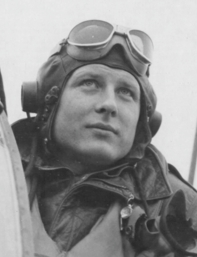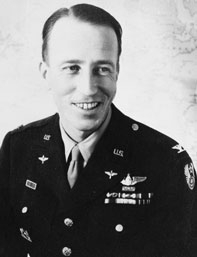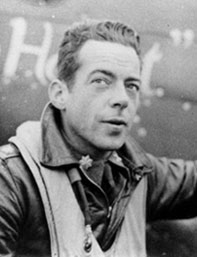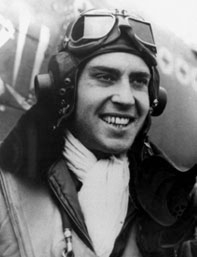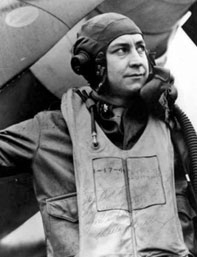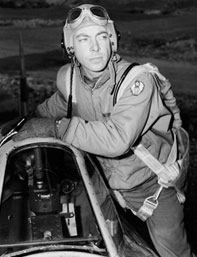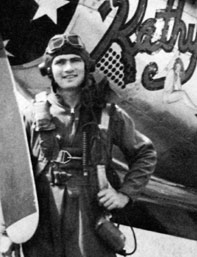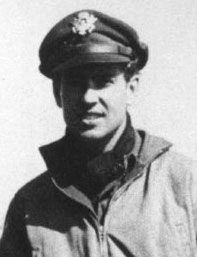Hatching of the 354th Fighter Group
By Capt. Arthur F. Brown, Capt. Fredrick S. Burkhardt and 1st Lt. Rudolph A. Tholt
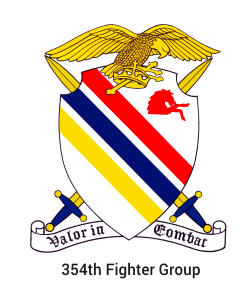
For a Group which was destined to play such an exciting, record-shattering and important part in great events to come, the hatching of the 354th Fighter Group was sadly inauspicious. Its nest was at Hamilton Field in the lovely hills just north of San Francisco Bay in California and the promising little egg was laid there on the 15th of November 1942. For eight days it was just an egg, nothing more but, on the 23rd of the month, the shell cracked and a funny little something which was to become so famous emerged and drew its first breath. There were no wings, no feathers, in fact, nothing that gave much promise. In less allegorical terms, the 354th Fighter Group existed on paper only from the 15th to the 23rd of November 1942 and, on the latter date, the first personnel was assigned to it, the first assigned being one Captain and three 1st Lieutenants, all medics from the 20th Fighter Group. On the next day four T/Sergeants and twenty-four privates were assigned and joined from Hammer Field. Our little bird was getting its feathers fast.
On November 26th, Major Kenneth R. Martin was assigned and took over the reins as the first Commanding Officer of the new Group with Major Wallace P. Mace as his Executive Officer. The three Squadrons of which the Group was to be made - the 353rd, 355th and 356th (at first designated as the 343rd) were commanded by Major Owen M. Seaman, Captain George R. Bickell and Captain Charles C. Johnson, respectively. By the end of November the personnel of the entire Group was comprised of nine officers and twenty-eight enlisted men. By the end of December our little nest contained thirty-four officers and five hundred and forty-five enlisted men.
After moving to places such as, Tonopah, Nevada, Santa Rosa Army Air Base, and Hayward, the Army Air Base at Portland, Oregon, the Group finally arrived at Camp Kilmer, New Jersey where, for ten days the 354th spent its time in repacking, acquiring still-needed equipment and in enjoying the social activities offered by New York City.
Off to War: The European Theater of Operations (ETO)
On the 20th of October 1943, the Group was marched to the siding at Kilmer, loaded again on trains for a short ride, transferred to the ferry for a trip across the Hudson to Manhattan where they went immediately aboard HMS "Athlone Castle", and settled down to wrestle with the hardship and worries of an ocean voyage aboard an army transport. The crossing was uneventful and the weather was at no time seriously bad nor the sea unusually rough, however the boat was crowded and living conditions were not the most enjoyable in the experience of the men. The ship was one of a large convoy and the journey was not too fast, land being sighted first on the last day of the month. The following day, November 1st the ship dropped anchor in Liverpool Harbor but it was not until noon on the 3rd that the boat moved from the roads into the dock, the delay being caused by the thick fog which hung over the harbor. The night of the 3rd was spent aboard ship at the dock and early the next morning the Group disembarked, entraining immediately at the dockside station. At approximately 1015 the train pulled out of the station and life in the ETO began for the 354th Fighter Group.
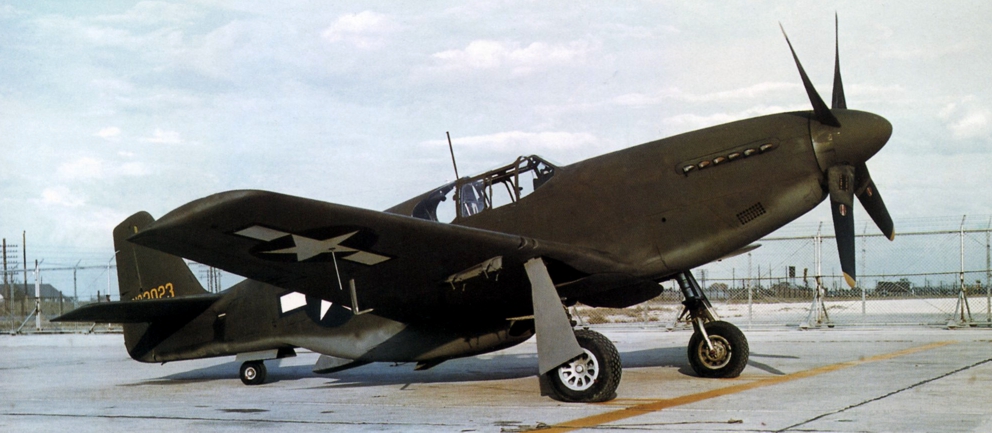
The P-51B Mustang in olive drab with light fuselage underside. This view empasizes the reatractable main gear and tail wheel and the under-fuselage coolant area that keep the Mustang vulnerable to low-level ground fire. North American Avation, Inglewood, Calif., 1943.
At 2015 hours that same day, personnel detrained at Newbury, Berkshire and was transported by truck to their first English base at Greenham Commons. The Group was here for only a short time and, on the 13th of November, they moved to a larger base at Boxted, near Colchester, Essexshire. Two days before leaving Greenham Commons, the Group received its first combat airplanes, the new and untried-in-combat P 51B, the highly reputed Mustangs. Our pilots were extremely happy to have this type plane assigned to them and after only one day of trial they realized that they had the airplane of the war to work with and, out of respect for the honor accorded the Group in being chosen to pioneer this new aircraft in combat in the European Theater, the Group adopted the name of the PIONEER MUSTANG GROUP. Later on, when the exploits of its pilots had made the name one to be reckoned with on the other side of the Channel the word FAMOUS was affixed to this title.
The planes took-off at 1429 hours and were all back by 1549, the only excitement having been one flak hit on the plane flown by Lieutenant Lane of the 356th Fighter Squadron, but already the Group had established a record-it had flown its first combat mission just twenty days after its first combat aircraft was assigned to it and just twenty-seven days after arriving in the ETO.
Two days after arriving at Boxted the Group celebrated its first anniversary as a unit mainly in unpacking and getting settled. But there wasn't any time wasted and final preparations for the great tasks to come were quickly completed so that, on the 1st of December, 1943, just three hundred and eighty days after that unpromising little egg had been dropped in the nest at Hamilton Field, California, U. S. A., our grown-up bird first took to the air to prove its wings over enemy territory from Boxted Airdrome, Essexshire, England. This introduction into combat operations was a comparatively short flight, by twenty-four of our aircraft, over Belgium and the Pas de Calais section of France; it was led by Lieutenant Colonel Blakeslee, Executive Officer of the combat tested 4th Fighter Group, with our Lieutenant Colonel Martin flying his wing. The planes took-off at 1429 hours and were all back by 1549, the only excitement having been one flak hit on the plane flown by Lieutenant Lane of the 356th Fighter Squadron, but already the Group had established a record-it had flown its first combat mission just twenty days after its first combat aircraft was assigned to it and just twenty-seven days after arriving in the ETO.
Long-Range Escort Missions
The Group developed quickly into one of the outstanding Groups in its theater of operations. In this short resume of the history of the unit, only passing reference can be made to the highlights of its accomplishments and details will have to be found in the more complete history of the organization in the files of the War Department or the Group itself. Not only was the 354th the first group to fly the Mustang in Europe but it was the first fighter Group to be assigned to the reorganized 9th Air Force which had just been brought to England from Africa. Just before going to France the Group became part of the XIX Tactical Air Command which was commanded by Brigadier (now Major) General Weyland and was assigned to the 100th Fighter Wing, commanded by Colonel (now Brigadier General) Sanders. Before being assigned to XIX TAC, the Group was a unit of the IX Fighter Command, headed by Brigadier (now Major) General Quesada. During all its operations on the Continent itself the Group, along with its Wing and Command, worked hand-in-hand with General Patton's 3rd Army and the team of 3rd Army and XIX TAC proved itself to be the greatest team of air-ground cooperation ever to fight for the Stars and Stripes and, along with all the other lower echelon units, the 354th Fighter Group contributed its share to the glory and accomplishments of this team.
The Pioneers remained at Boxted until the 17th of April 1944 and this was the longest period it was to spend on one field until after hostilities ceased in the ETO. It was during these first months of combat flying that the Group proved the worth of the new Mustangs as long range fighters and escort planes. The heavy bombers of the 8th Air Force were by this time making almost daily raids far into the Reich attacking priority targets in the over-all strategic air plan which later was to be credited by the Germans themselves the greatest single factor in their final defeat. But the farthest reaches of their attacks could not be covered by the protecting Thunderbolts, nor supported by the somehow inadequate Lightings, which were their only escort until the advent of the 354th with its long-range Mustangs. Thirteen days after their initial combat mission, on the 13th of December 1945, the Pioneer Mustangs escorted Eighth Air Forces heavies on a raid to Kiel, Germany, which, to date was the greatest daylight bombing raid of the war in addition to being the first on which the bombers had enjoyed all-the-way escort from Allied fighter planes (on a mission of this length) their stay in the target area being covered by P-51's of the 354th Fighter Group. From this day on missions became larger and longer until, on the last day of the year, our planes gave target and penetration support to heavies attacking objectives as far away as Bordeaux, France. Thus was the Mustang proven.
During January of 1944, Lieutenant Colonel Martin became Colonel Martin and Major Howard then commanding the 356th Fighter Squadron, earned himself the Congressional Medal of Honor for his heroic work on the mission of January 11th when he, single-handed, warded off upwards of thirty enemy aircraft which were attempting to get through to the bombers. Major Howard claimed only three of the enemy planes destroyed but members of the bomber crews who witnessed his "one-man blitz" swear he shot down at least six of the Krauts. Exactly one month after Major Howard's famous exploit, on February 11th, Colonel Martin was lost in a head-on collision with an enemy plane. His loss was deeply felt by every member of the Group and it was with great relief that word was later received that he had landed safely though badly injured and was a German Prisoner of War. When the war was almost over he made his escape and returned to spend a few days with the Group at its first base in Germany. Major Howard took over command of the 354th and was promoted to the rank of Lieutenant Colonel, both changes dating from the 11th of February. On April 7th, Lieutenant Colonel Howard became Colonel Howard, less than eleven months ago. A few days after his promotion Colonel Howard was taken from the Group for a more important job at a higher headquarters and the Group was taken over by Lieutenant Colonel Bickell, until that time Commanding Officer of the 355th Fighter Squadron, Lieutenant Colonel Mace had previously been transferred from the Group, which he had served as Deputy Commander since its activation, to higher Headquarters at which time Lieutenant Colonel Bickell had become Group Deputy Commander then under Lieutenant Colonel Howard.

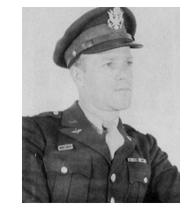 These pages contain the proud story of the 354th Pioneer Mustang Fighter Group. Untried in combat and at a crucial period in the aerial battle of Europe they entered the conflict with
a new aircraft... the P-51 Mustang. By their indomitable spirit and gallant courage they completed an enviable record in 18 months of combat operations. To tell this saga of the ETO's "top" fighter group would require volumes. I can only hope to touch upon the high spots of this outstanding record of achievement. The men of the Pioneer
Mustang Group have added another glorious page to military history of the United States.
These pages contain the proud story of the 354th Pioneer Mustang Fighter Group. Untried in combat and at a crucial period in the aerial battle of Europe they entered the conflict with
a new aircraft... the P-51 Mustang. By their indomitable spirit and gallant courage they completed an enviable record in 18 months of combat operations. To tell this saga of the ETO's "top" fighter group would require volumes. I can only hope to touch upon the high spots of this outstanding record of achievement. The men of the Pioneer
Mustang Group have added another glorious page to military history of the United States.
